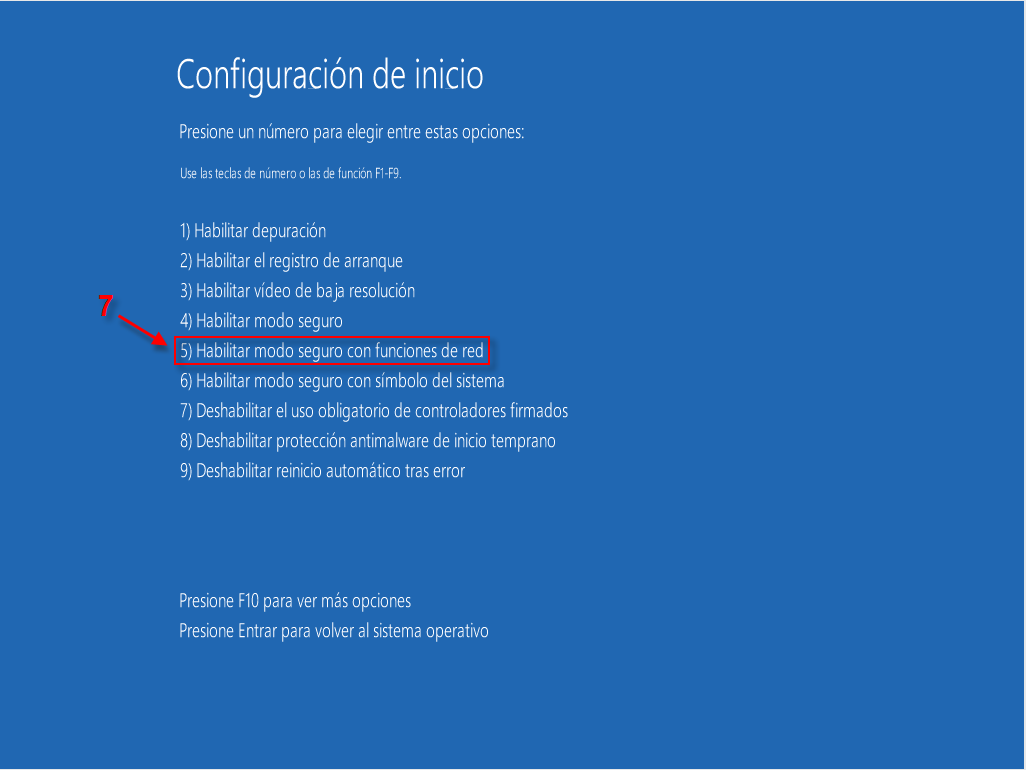Have you ever wondered What is safe mode for in Windows 10? If so, you are in the right place, because here we will teach you everything you need to know about the safe mode in Windowa 10.
What is safe mode for in Windows 10?
You want to know what is safe mode for in Windows 10? In this article you will find everything related to this interesting topic, from its meaning to its usefulness and ways to start.
What is safe mode in Windows?
Safe mode in Windows is a boot alternative that is mainly used when the operating system is unstable. In such a way that the computer starts only with the minimum drivers and services for its operation and operability.
In this regard, it is important to note that while the safe mode is active, the functionality of the equipment is reduced. In the same way, we must be clear that it is not always possible to recover 100% of the operation of the operating system.
What is safe mode for in Windows 10?
Generally speaking, the safe mode serves to restore peace of mind to the operation of the computer. So if you don't understand the importance of Windows 10 security, the answer is pretty straightforward.
In principle, the safe mode in Windows 10 allows you to eliminate any virus or malware threat that is present on the computer. As well as it offers the opportunity to fix a driver that is damaged.
Additionally, it allows you to restore the system to a previous version, if the current one is giving us problems. In addition, we can uninstall programs or applications, as well as it is also possible to update the equipment's drivers; however, no software can be installed.
In short, Windows safe mode allows us to perform basic maintenance tasks that help us optimize the operation of the computer. In this regard, this is possible thanks to the system diagnostic option, which gives the user the opportunity to fix most of the problems on their own.
How does Windows 10 safe mode work?
Basically, when safe mode starts the operating system it temporarily disables a number of drives, both internal and external, minus the basic data input and output devices. This in order to prevent any virus, malware or driver in conflict from interfering with the startup of the computer.
In such a way that, when the administrator is visible, it is possible to access, modify or delete the files that affect the proper functioning of the system. In this regard, it is clear that the permissions of said administrator are needed, because otherwise it is not possible to access the system, much less modify any of its elements.
What types of safe mode are there in Windows 10?
Generally speaking, the Startup Settings menu allows us to choose between three safe mode options. These are:
Safe mode: Allows Windows to start only under the minimum drivers and services to boot. It is activated by pressing the F4 key.
Safe Mode with Networking: This option allows Windows to start in safe mode, while allowing access to the Internet and the network. It works by pressing the F5 key.
Safe mode with command prompt: In general terms, this option starts safe mode with a command line window and is activated when we press the F6 key. It is an advanced method, the use of which is recommended preferably by specialists in the area.
In the following video you can see the functions of each of the options related to starting in safe mode in Windows.
However, we'll show you later on how to start Safe Mode with Command Prompt. In this regard, it is important to clarify that this method is used when the Startup Settings does not appear on the screen.
What should I do to start safe mode in Windows 10?
Starting safe mode in Windows 10 is easier than you might think. Well, we only need to press the Shift key, at the same time that we click on the Restart option, within the Start menu.
Another way to start safe mode in Windows 10 is to access the system settings, using the Msconfig tool. To do this, we open the Run menu through the command Logo Win + R, write Msconfig and click on the OK option.
Next, in the Startup tab, we select the Safe Startup option, leaving the box corresponding to Minimum checked. Finally, we click on Accept to save the changes made.
In the following video, you can see more information on this topic, as we show you three different ways to obtain good results.
Is there another procedure to start safe mode in Windows 10?
Indeed, Windows 10 offers us another alternative to enter safe mode. Here's how to do it.
The first step is to use the search box to go to the Windows Recovery Options. On the next screen we select the Advanced startup option and then click Restart now.
The next thing is to click on the option Troubleshoot and in the next window, select Advanced options. Then, we click on See more recovery options and then we click on the Startup Settings option.
Next, we choose the Restart option. In this regard, when the computer restarts, all the available options appear on the screen: safe mode, safe network mode and safe mode with the command prompt.
In this way, depending on the chosen mode, we must press one of the following keys respectively: F4, F5 or F6; The following is to log in with our Windows username and password; in this way we have managed to enter safe mode in Windows 10.
Finally, when we finish solving the problems, we go to the Start menu and press the Start / Shutdown key. Next, we click where it says Restart so that the computer starts up in normal mode.
How can I start safe mode with command prompt?
First, we must turn on the computer and repeatedly press the Esc key, until the Start menu appears. Next, we press the F11 key and, in the list of options that are shown to us, we choose Troubleshoot.
Next, we click where it says Advanced options and, on the next screen, we select the command prompt. When the next window opens, it is time to enter the command according to our preference.
Commandos
In this regard, according to what we have already mentioned, we have three possible options to start safe mode in Windows 10. These are:
Safe mode: We write the command bcdedit / set {default} safeboot minimal. Next we press the Enter key.
Safe mode with network connection: The command indicated for this option is, bcdedit / set {default} safeboot nextwoork. Next, we press the Enter key.
Safe mode with the command prompt: This option is possible by using two commands, these are: bcdedit / set {default} safeboot minimal and bcdedit / set {default} safebootalternateshell yes.
In this regard, it is important to note that it is necessary to press the Enter key after typing the first command, and also after the second. Subsequently, it does not matter which command was used, a message is displayed on the screen indicating that the procedure has been completed correctly.
Log in
Then, it only remains to click on the X that appears in the upper right corner of the screen. Thus we managed to close the window and we can choose Continue in the following list of options.
Finally, we enter our Windows username and password and access the computer's desktop in safe mode. When we finish making the changes, we restart the computer to exit that mode.
However, without entering through the command prompt, it will not be enough to restart the computer. Next, we will show you how to get out of safe mode in that case.
How do I get out of safe mode with the command prompt?
The process to exit safe mode with the command prompt in Windows 10 is very similar to the one we follow to enter. In this way, we must turn off and on the computer; then we repeatedly press the Esc key until the Start menu opens.
Subsequently, we press the F11 key and select the Troubleshoot option, followed by Advanced options. Next, we click on the command prompt and, on the next screen, we write the command that allows us to exit safe mode.
In this way, we write bcdedit / deletevalue {default} safeboot and press the Enter key. Finally, we close the window by clicking on the X that appears in the upper right corner of the screen, and we choose the Continue option so that the computer starts up in normal mode.
What do I do if my operating system is older than Windows 10?
As with Windows 10, starting safe mode in previous versions is fairly straightforward. For example, if your operating system is Windows 8, all you have to do is hold down the Shift key, at the same time that we click on the Start / Shutdown button.
On the contrary, if your operating system is older than Windows 8, the procedure is a little less simple. Well, in this case, we must wait for the computer to start from the BIOS, but before it loads the Windows startup screen.
So that is the right time to hold down the F8 key. Next, within the list that appears below, we select the Safe Mode option.
What is the difference between safe mode in Windows 10 and normal mode?
The difference between the safe mode in Windows 10 and the normal mode lies, mainly, in the boot speed and in the possibility of testing configurations to solve a particular problem. Among them, those that we have mentioned before: from eliminating viruses and malicious codes, to correcting failures in drivers or applications, even updating programs or returning to previous versions of the operating system.
If you want to learn a little more about this topic, I invite you to read the article: Repair startup Windows 10 Do It Right!
On the other hand, when the safe mode is started the monitor screen remains black; in addition, in each corner it indicates that this mode is activated. Finally, the version of the operating system is displayed at the top of the screen.
Warnings
Even though we have explained in detail what safe mode is for in Windows 10, it is necessary to warn about some aspects. First of all, this startup tool is also known as Safe Mode.
On the other hand, it is usually necessary to try several configurations before finding the root of the problem and, therefore, the solution of it. In other words, sometimes we have to alternate several times between starting in safe mode and starting in normal mode, until we verify that the problem has disappeared.
Finally, in general, the safe mode in Windows 10 is quite reliable when it comes to diagnosing and solving problems inherent to the operation of the computer. However, it is not always possible to fix all equipment problems, as sometimes the damage is simply irreparable.
Regarding this last aspect, if that is the case, it is best to reinstall the operating system from scratch. In this regard, it is best to make a backup copy of all the information that we want to keep.





